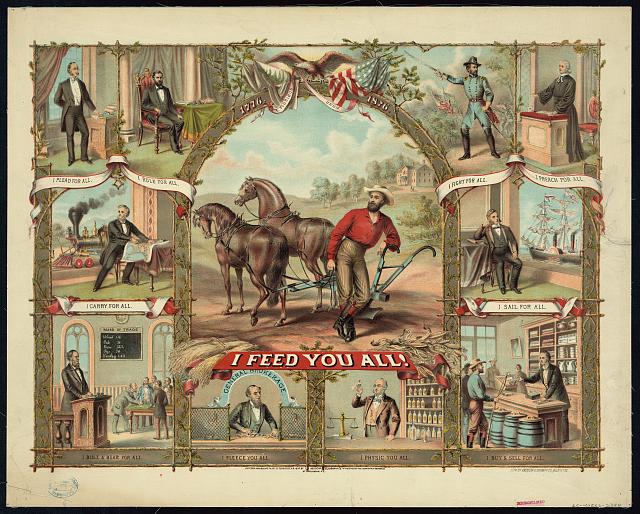The Grange. No, not the popular ZZ Top song from 1973—the late nineteenth-century movement of farmers, politicians, and economists that tried to improve the lives and conditions of rural Americans at a time of financial crisis. For AP® US History, The Grange represents a time when Americans were exploring new social, political, and economic options. These were the reformers looking for a new cooperative rural America, and they swept across the country at a time when national finances were a mess.
All of these topics (except for maybe ZZ Top) are essential to the AP® US History course and exam. This AP® US History crash course review will get into the nitty-gritty detail of the Grange movement, letting you know how it all began, what its members wanted, and how it eventually began to collapse in US history. But perhaps more importantly, as any good APUSH review will do, this crash course guide will let you in on what APUSH exam-makers want you to know when studying for the exam.
The Origins of the Grange Movement
The Grange is (yes, it’s still around) actually officially called the National Grange of the Order of Patrons of Husbandry. But The Grange is so much easier to say, right? It was founded right after the Civil War, in 1867, when Southern farms were still decimated from the fighting. President Andrew Johnson sent some advisers on a tour through the South to see what farming was like, and was actually totally blown away with how terrible farming practices were. Soon enough, the fraternal organization was create, whose members were going to be called Grangers, under the idea that Northern and Southern farmers needed to work together in order to get farming back on track and be productive for the whole country.

It should also be noted, that although The Grange was a fraternal organization, women were seen as essential members, even holding elected positions in the organization over the years. But this type of info shouldn’t really pop up on the APUSH exam, it’s more of a FYI thing.
The Grange Becomes a Force
The first decade or so of membership was slow moving. But then the Panic of 1873 happened, and Grange membership skyrocketed. Farmers, in particular, were hit hard by the financial crisis, especially since low prices for agriculture spread throughout the country, farmers found themselves in increasing debt to banks, and railroads raised the prices to ship agricultural goods through the nation. So, farmers became Grangers in order to find a solution.
With growing membership and support, The Grange began to spread their influence all across the country. They believed that the farm held the country together and that every American relies on the farmer, so they wanted to make sure that the farmer was heard in all things political, social, and economic. With increased membership fees, Grangers began petitioning politicians for measures that would be beneficial to farmer. They even supported a number of other reformist movements in the country, including women’s’ suffragists, the Populists, and the Greenback Party.
What Did the Grange Want?
Here are a few examples of what Grangers wanted from Local and State governments to help them with (the comments in parentheses are what you really want to know for the AP® US History exam, so pay attention to these comments):
- The ability for farmers to cooperatively purchase farm equipment and other supplies needed to run their farms. (APUSH Note: This would have allowed them to purchase in bulk and therefore push the prices of farming goods down, making them more accessible)
- The ability to legally pool together the savings of each farmer into one spot. (APUSH Note: Grangers believed that bank, being from the city were corrupt, so they looked for an alternative. These were early versions of credit unions.)
- The ability for farmers to create cooperative grain elevators that allowed farmers to hold onto grain and other goods for a better time to sell. (APUSH Note: This is important because it would give farmers, instead of banks or the government, the power to control the prices of grain and other nonperishable goods)
- The ability to build and manufacture their own farm equipment. (APUSH Note: This is where things would go wrong. Grangers attempted to get into industry and manufacturing, leading to the loss of large amounts of money and support.)
What Did The Grange Get?
Grangers weren’t always successful in their appeals for social, political, and economic reform but they were able to make some important contributions. In particular, many local organizations created consumer cooperatives, putting the business side in the hands of farmers and consumers. They were also able to successfully get the local governments to begin regulating railroad and grain warehouses
At their peak, they successfully argued to the Supreme Court that grain warehouses were a “private utility in the public interest,” meaning that the public could regulate them and not the private railroad companies.
But things soon took a turn downhill. That Supreme Court decision, originally ruled in 1877, was overturned in 7896. Membership grew rapidly and funds were often mismanaged, including efforts to get into the manufacturing industry, which did not end up so well.
What You Need to Know for the AP® US History Exam
Successes or not, The Grange is symbolically important and essential to understand in context for the AP® US History exam. This AP® US History crash course review has shown how Grangers united in the rubble of the Civil War, cooperated in order to keep rural farming strong in the country, and declined largely due to paradoxical successes.
But what do you need to know for the APUSH exam? I’m glad you asked. Generally, you need to think about this as a reform movement. View it as single movements amongst many that popped up in the late nineteenth century and one that attempted to come to terms with growing economic equality, the rise of industry, and an increasingly volatile economy.
For Grangers, they believed that farming unified all segments of society and that if all farmers banded together, they could fight large political and economic problems that they believed were causing problems in the country, like big business and political corruption. But, again, they were not the only ones.
Take a look at this DBQ from the 2012 AP® US History exam. It asks students to analyze this statement:
In the post–Civil War United States, corporations grew significantly in number, size, and influence. Analyze the impact of big business on the economy and politics and the responses of Americans to these changes. Confine your answer to the period 1870 to 1900.
Although there is no specific document from The Grange itself, you can see how they might fit into a question like this right? Just like a large number of other movements (even those represented by the documents in this APSUH DBQ), The Grange emerged from economic inequality and volatility, sought a solution based on a popular and political grassroots movement, and attempted to influence political agendas away from huge corporate interests. Just look at this picture and ask yourself, how did The Grange view themselves as necessary and essential members of American society? What were their goals?

“I feed you all!” lithograph by American Oleograph Co., Milwaukee, ca. 1875. (Library of Congress Prints and Photographs Division)
Image Source: Library of Congress
This AP® US History crash course review has given you insights into the answers to these questions providing you with the history of the Grange movement, their influences in American politics and society, and they ways that it might pop up on the next APUSH exam. Good luck!
Let’s put everything into practice. Try this AP® US History practice question:
Looking for more APUSH practice?
Check out our other articles on AP® US History.
You can also find thousands of practice questions on Albert.io. Albert.io lets you customize your learning experience to target practice where you need the most help. We’ll give you challenging practice questions to help you achieve mastery of AP® US History.
Start practicing here.
Are you a teacher or administrator interested in boosting AP® US History student outcomes?
Learn more about our school licenses here.









